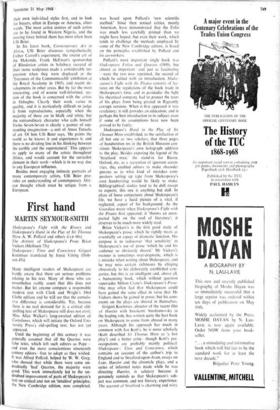Black arts
J. B. DONNE Yoruba Religious Carving Kevin Carroll (Geoffrey Chapman 90s) Modern Makonde Sculpture J. Anthony Stout (Trench Trubner, distributed by Kegan Paul cloth 60s, paper 40s) Contemporary Art in Africa Ulli Beier (Pall Mall 55s) In Africa, and particularly Africa -south of the Sahara, one of the most startling and unex- pected results of the rapid political and eco- nomic development in the postwar years, and the achievement of independence by so many nations from the late 'fifties onwards, has been the creation of a contemporary African art as distinct from the traditional arts. In many areas African traditional or tribal art had long been undergoing a process of degeneration or decay—and not always due to the direct inter- vention of Europeans. In fact, it was often Europeans who tried to hold this process in check by finding new outlets for African wood- carvers and bronze-casters.
One of the earliest of these was Father Kevin Carroll, who in 1947 set up a centre in the small town of Oye Ekiti in Western Nigeria for the purpose of studying 'the adaptation of African crafts to Christian uses.' Employing pagan and Moslem as well as Christian carvers, he invited them to produce church doors, panels, crib-sets and madonnas in the tradi- tional Yoruba style. He describes the results of this experiment in Yoruba Religious Carving, and provides numerous illustrations not only of the Christian carvings but also of both old and recent traditional works. It is sad to relate that, despite much understanding and well- intentioned effort, the loss of vitality, the sense of copying rather than creating, and the poorer workmanship of so much recent traditional Yoruba carving appears to have been repeated in the work commissioned by the Catholic church. In 1953, the centre was closed down, though commissions continued to flow from individual church communities. Perhaps the traditional approach was wrong. Perhaps Father Carroll was just a few years ahead of his time. But his accounts of individual carvers make fascinating reading.
On the other side of the continent, in Tan- zania, the woodcarvers of the Makonde tribe, famous for their fraditional masks and figurihes, were being employed, often full-time, by the European owners of gift shops to produce tourist 'pieces. The carvers were usually given free rein, and what is so curious is that instead of making copies in the traditional style they evolved a completely new, nightmarish, type of figure-carving, previously unheard of. J. Anthony Stout, an American psychologist working in Tanzania, made a collection of these objects and mounted an exhibition of them in 1965 at the Kibo Art Gallery, Kiliman- jaro. He has now produced an illustrated and fully annotated catalogue entitled Modern Makonde Sculpture. Despite the frankly tourist origins of this sculpture, it bears no re- semblance to other tourist or 'airport' art; instead, its surrealist nature is comparable with that of much recent art in other parts of Africa. inspired by neither tourists nor the church.
Only since 1960 have many African artists been sufficiently independent economically to be able to avoid working for Europeans on a commission basis—to produce their work in their own individual styles first, and to look for buyers, often in Europe or America, after- wards. The most active centres of such artists are to be found in Western Nigeria, and the moving force behind them has most often been Ulli Beier.
In his latest book, Contemporary Art in Africa, Ulli Beier discusses sympathetically Father Carroll's experiment, the tourist art of the Makonde, Frank McEwen's sponsorship of Rhodesian artists in Salisbury (several of their stone sculptures made a considerable im- pression when they were displayed at the 'Treasures of the Commonwealth' exhibition at the Royal Academy in 1965), and recent de- velopments in other areas. But by far the most interesting, and of course well-informed, sec- tion of the book is concerned with the artists in Oshogbo. Clearly their work varies in quality, and it is particularly difficult to judge it from reproductions, especially when the majority of these are in bladk and white, but the extraordinary character who calls himself Twins Seven-Seven, is clearly a painter of out- standing imagination—a sort of Amos Tutuola of art. Of him Ulli Beier says, 'He paints the world as he knows it and experiences it, and there is no dividing line in his thinking between the earthly and the supernatural.' This appears to apply to many of the artists throughout Africa, and would account for the surrealist element in their work—which is in no way due to any European influence.
Besides most engaging intimate portraits of many contemporary artists, Ulli Beier pro- vides an understanding of contemporary Afri- can thought which must be unique from a European.







































 Previous page
Previous page